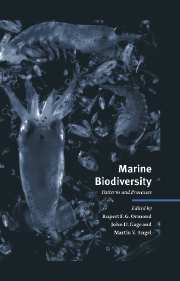Book contents
- Frontmatter
- Contents
- List of contributors
- Foreword: The value of diversity
- 1 Marine biodiversity in its global context
- 2 Gradients in marine biodiversity
- 3 Pelagic biodiversity
- 4 Biological diversity in oceanic macrozooplankton: More than counting species
- 5 Large-scale patterns of species diversity in the deep-sea benthos
- 6 Diversity, latitude and time: Patterns in the shallow sea
- 7 High benthic species diversity in deep-sea sediments: The importance of hydrodynamics
- 8 Diversity and structure of tropical Indo-Pacific benthic communities: Relation to regimes of nutrient input
- 9 Why are coral reef communities so diverse?
- 10 The biodiversity of coral reef fishes
- 11 The historical component of marine taxonomic diversity gradients
- 12 Population genetics and demography of marine species
- 13 Discovering unrecognised diversity among marine molluscs
- 14 Ecosystem function at low biodiversity – the Baltic example
- 15 Land–seascape diversity of the USA East Coast coastal zone with particular reference to estuaries
- 16 The development of mariculture and its implications for biodiversity
- 17 Protecting marine biodiversity and integrated coastal zone management
- 18 Conserving biodiversity in North-East Atlantic marine ecosystems
- Author index
- Species index
- Subject index
18 - Conserving biodiversity in North-East Atlantic marine ecosystems
Published online by Cambridge University Press: 04 August 2010
- Frontmatter
- Contents
- List of contributors
- Foreword: The value of diversity
- 1 Marine biodiversity in its global context
- 2 Gradients in marine biodiversity
- 3 Pelagic biodiversity
- 4 Biological diversity in oceanic macrozooplankton: More than counting species
- 5 Large-scale patterns of species diversity in the deep-sea benthos
- 6 Diversity, latitude and time: Patterns in the shallow sea
- 7 High benthic species diversity in deep-sea sediments: The importance of hydrodynamics
- 8 Diversity and structure of tropical Indo-Pacific benthic communities: Relation to regimes of nutrient input
- 9 Why are coral reef communities so diverse?
- 10 The biodiversity of coral reef fishes
- 11 The historical component of marine taxonomic diversity gradients
- 12 Population genetics and demography of marine species
- 13 Discovering unrecognised diversity among marine molluscs
- 14 Ecosystem function at low biodiversity – the Baltic example
- 15 Land–seascape diversity of the USA East Coast coastal zone with particular reference to estuaries
- 16 The development of mariculture and its implications for biodiversity
- 17 Protecting marine biodiversity and integrated coastal zone management
- 18 Conserving biodiversity in North-East Atlantic marine ecosystems
- Author index
- Species index
- Subject index
Summary
Abstract
Maintaining biodiversity is a central tenet of wildlife conservation. To conserve marine life, information on the ‘resource’ (the habitats, communities and species) needs to be collected and used in a structured way in order to identify the nature conservation importance of sites and to manage areas to conserve their important features. This includes the organisation of descriptive data through systems of classification and the establishment of criteria for assessing the nature conservation importance of locations. Management requires information on the functioning of marine ecosystems, but especially an understanding of how vulnerable particular habitats, communities and species are to different activities being undertaken in the area. Research needs to tackle some difficult applied questions that will not always suit the requirements of publishing and of short project length.
Introduction
‘Nature conservation’ is defined here as: ‘the regulation of human use of the global ecosystem to sustain its diversity of content indefinitely’ (NCC, 1984). Conservation requires information on the resource and a structured approach to decision-making so that actions are soundly based and defensible. Conserving biodiversity also requires political initiatives and will. Recent such initiatives have included the United Nations Convention on Biodiversity (published in Britain by the Foreign and Commonwealth Office, 1995) and the European Communities Directive on the Conservation of Natural Habitats and of Wild Fauna and Flora (Council of the European Communities, 1992).
- Type
- Chapter
- Information
- Marine BiodiversityPatterns and Processes, pp. 415 - 428Publisher: Cambridge University PressPrint publication year: 1997
- 6
- Cited by



